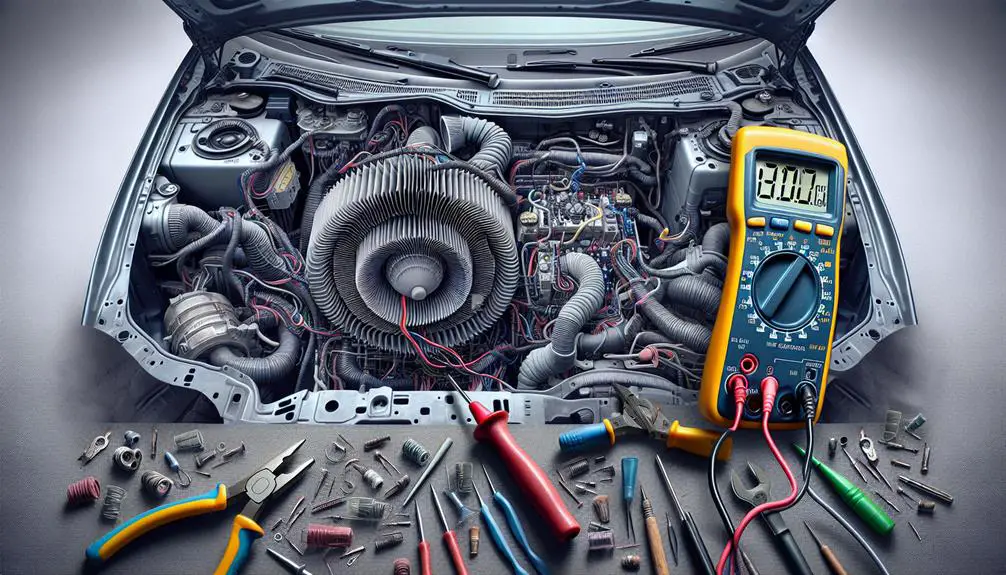To check if your blower motor is bad, inspect the fuse and relay, test electrical connections, and evaluate the blower motor resistor.
Facing a faltering fan in your vehicle can be frustrating, especially when you're unsure if the blower motor is to blame. You've likely noticed unusual noises or a decline in airflow strength, signaling it's time for a checkup. By inspecting the fuse and relay, testing electrical connections, and evaluating the blower motor resistor, you can diagnose the issue with precision.
Yet, grasping the intricacies of each step and the common pitfalls to avoid can make all the difference in accurately determining the health of your blower motor. Let's investigate how you can confidently confirm your suspicions and possibly save yourself from future headaches.
Listen for Unusual Noises

One of the initial signs of a failing blower motor is the emergence of strange sounds when it's operating. You'll notice it's not the usual hum but rather a series of unusual noises that signal something's off. These could range from high-pitched squeals to grinding or rattling sounds, indicating different issues within the blower motor. Listening closely to these noises can help you pinpoint the problem.
If you're hearing squealing, it often means the bearings in the blower motor are starting to fail. These components are critical for smooth operation, and once they wear down, they produce a high-pitched noise that's hard to ignore.
On the other hand, a grinding noise might suggest a more severe problem, such as components inside the motor coming loose or breaking apart. This type of sound usually requires immediate attention, as it could lead to a complete motor failure if not addressed quickly.
Rattling is another common noise you might encounter. It typically indicates something is loose within the blower assembly. While it mightn't sound as serious as grinding, it's still a sign that the blower motor isn't functioning correctly and needs a check-up.
Paying attention to these noises and identifying them early can save you from bigger issues down the line. Don't ignore them hoping they'll go away on their own. Instead, use them as your critical clue that it's time to inspect your blower motor or call in a professional for a more in-depth look.
Check Airflow Strength
After tuning into unusual noises, it's essential to evaluate the strength of your blower motor's airflow to guarantee it's operating efficiently. Weak airflow can be a clear indicator that your blower motor isn't performing as it should. Here's how you can check the airflow strength in a simple manner:
- Turn on Your Vehicle's HVAC System: Start by switching on your car's heating, ventilation, and air conditioning (HVAC) system. Make sure to set it to the highest fan setting. This increases the demand on the blower motor, making it easier to assess its performance.
- Feel the Airflow at Different Vents: Position your hand in front of the different vents inside your vehicle. You're looking for a strong, consistent stream of air. If the airflow feels weak or there are significant variations in strength between the vents, this could suggest a problem with the blower motor or related components.
- Check Airflow at Different Speed Settings: After testing on the highest setting, adjust the fan speed to lower settings. The airflow should decrease proportionally. If the airflow doesn't change or drops off significantly, it might indicate an issue with the motor's ability to modulate airflow properly.
- Assess Air Temperature Consistency: While this step primarily checks for heating and cooling issues, inconsistent air temperatures can also strain the blower motor. Notice if the air temperature fluctuates without you changing the settings. This could indirectly affect airflow and might signal a problem.
Inspect the Fuse and Relay

Before proceeding further, it's crucial to inspect the fuse and relay associated with your vehicle's blower motor for any signs of wear or failure.
The fuse basically acts as a safeguard for the blower motor's electrical circuit. If the motor draws too much power, the fuse will blow, preventing potential damage. Locating the fuse is your initial step. You'll typically find it in the fuse box under your car's dashboard or under the hood. Consult your vehicle's manual for the exact location. Once you've found the fuse, examine it for any signs of damage. A blown fuse is usually easy to spot; it'll have a broken wire or a discolored glass window.
If the fuse looks good, it's time to move on to the relay. The relay is a switch that controls the power to the blower motor, allowing it to turn on or off. Like the fuse, the relay can be located in the fuse box. It's slightly larger than a fuse and usually black or gray. To inspect the relay, you're looking for any signs of burning or melting. Sometimes, the problem isn't visible, so tapping the relay lightly or wiggling it can help. If it seems loose or you hear something rattling inside, it might be faulty.
Test the Electrical Connections
To guarantee your blower motor's best performance, it's critical you check the electrical connections for any issues. Faulty connections can lead to poor motor performance or complete failure, so it's essential to catch these problems early. Testing the electrical connections involves a few straightforward steps that you can do with some basic tools.
Here's how you can make sure your blower motor's electrical connections are in top shape:
- Disconnect the Battery: Before you start, always disconnect the battery to prevent any electrical shocks or short circuits. Safety should be your top priority.
- Inspect the Wiring Harness: Look for any signs of wear, tear, or corrosion on the wiring harness that connects to the blower motor. Corroded or damaged wires can interrupt the power supply, causing the motor to malfunction.
- Check for Loose Connections: Make sure that all connections are tight and secure. A loose connection can lead to intermittent blower operation or no operation at all. Tighten any loose connectors you find.
- Use a Multimeter: Set your multimeter to the continuity setting and check for continuity between the blower motor connector and the ground. Lack of continuity could indicate a break in the circuit, which requires further investigation or repair.
Assess Blower Motor Resistor

Once you've checked the electrical connections, it's essential to assess the blower motor resistor to make sure your system operates smoothly. This component controls the speed of the blower motor and, if faulty, can cause it to work improperly or not at all. Here's how you can check the blower motor resistor yourself.
Initially, locate the resistor. It's usually mounted to the HVAC unit in the dashboard or near the blower motor itself. Once you've found it, you'll want to visually inspect the resistor for any signs of damage or corrosion. If everything looks good visually, the next step is to test it with a multimeter.
Set your multimeter to the ohms setting and check for continuity between the resistor's terminals. The readings should match the manufacturer's specifications. If not, it's a sign that the resistor may be faulty. Below is a table that could help illustrate typical signs to look out for when inspecting and testing the blower motor resistor.
| Symptom | Possible Cause | Action to Take |
|---|---|---|
| Blower motor stuck on one speed | Faulty resistor | Replace resistor |
| Blower motor not working at all | Broken circuit in resistor | Replace resistor |
| Intermittent blower operation | Loose connections or damaged resistor | Secure connections or replace resistor |
| Overheating smell from vents | Resistor overheating due to failure | Replace resistor immediately |
| No air from vents at certain settings | Part of the resistor failed | Replace resistor |
Conclusion
You've now learned how to diagnose a faulty blower motor by:
- Listening for odd noises,
- Checking the airflow strength,
- Inspecting the fuse and relay,
- Testing the electrical connections, and
- Evaluating the blower motor resistor.
If you've found issues in any of these areas, it's likely your blower motor's at fault.
Remember, tackling these steps guarantees your HVAC system runs smoothly, and you stay comfortable no matter the season.
Don't hesitate to consult a professional if you're unsure about the diagnosis.